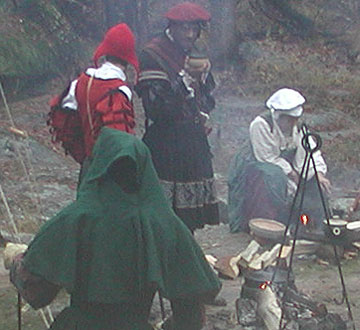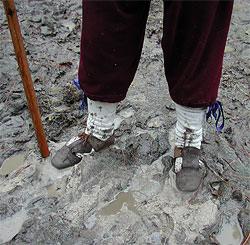 |
"Where have you come from?" "From Hell!" |
 |

|
A siege was almost as hard on the attackers as it was the defenders. Granted, attackers did not have their food supply cut off - usually. An army coming to relieve the beleagured fort could in turn surround the besiegers and stop their inflow of needed supplies. If that did not happen, an insidious dilemma sometimes gradually reared its head: armies at that time tried to live off the land and, settling in for a siege, a surrounding army depleted the local resources. As weeks went by, foraging and resupply had to extend out farther, ratcheting up costs, transport time and risk of enemy interference. Add to that the certain progression of seasons, bringing sleet, snow and cold wind that eroded men as they sat in the mud.
Those intent upon besieging a fort had to anticipate losses, sometimes severe. When Charles I embarked an English force to relieve La Rochelle in 1628, 7,833 boarded the ships - but a mere 2,989 returned home five months later. During an earlier siege of La Rochelle, in 1573, the numbers of Catholic attackers were so depleted in eight assaults that their commander, the Duke of Anjou, was forced to assign nobles to guard duty in the trenches. Remaining soldiers refused to make further assaults and officers were cashiered for running away from the defenders' sorties. Initially around 18,000 men, Anjou's army lost 5-6,000 to combat plus uncounted more to disease and desertion. Devastating, too, most of the regimental and company leaders were killed; in all more than 200 officers and gentlemen fell.
From inside their fortifications at Bergen-op-Zoom in 1622, the Dutch watched the surrounding enemy's army crumble away. The Army of Flanders under Spinola shrank from 20,600 to 13,200 in three months. Of those lost, about 2,500 ran away to the very fort they were besieging, begging for asylum. "From dawn till dusk one could see the soldiers jumping like rabbits from their holes, leaving the trenches, hedges, thickets and ditches where they had hidden, in order to run breathless to the town." Once there, the embittered Spanish soldiers begged for "a little bread and a little money" (and a passage home) and reported lack of pay and officers who drove them to attack with blows. An Italian from that army made his way painfully to the walls where the watch called out "Where have you come from?" His answer: "From Hell!" The Army of Flanders withdrew soon thereafter.
Commanders of besieging forces knew the sooner their targeted fort could be made to surrender or be taken, the fewer casualties their armies would suffer. Likewise, the defense knew that time could be an ally as well as an enemy and, occurring with sufficient frequency to give any defender heart, the besiegers could abandon the siege and leave. They left behind grim evidence of their own suffering.
A disease usually associated with the First World War, trench foot, was around in this period. With besiegers huddled and working in their trenches in the rain and snow, this comes as no surprise. Some men lost entire feet, not just toes, and others had gangrene set in.
Christmas Day, 1643, after the Royalists under Prince Maurice pulled out of their siege of Plymouth, the Parliamentarian defenders ventured out to investigate where their enemy had been. They found about 660 Royalists remaining in the trenches, still alive, but too sick or wounded to move.
Charles V lost Metz in 1551 to resurgent German Protestants and the forces of France's Henry II. A year later - but late in the season - Charles V launched his army of 55,000 to recapture the fortified city held by only 5,800. Although attackers fired over 7,000 artillery rounds against one wall, bringing down about 70 feet of it, they could not silence the defender's cannons on the flanks of the breach - plus the collapse revealed defenders had made a retirata - and therefore the Habsburg army didn't dare assault with infantry. Cold, wet weather set in. Following that army's withdrawal on December 26, 1552, defenders discovered sick and dying Habsburg soldiers left behind. "There were wretched men on all sides, some half-dead, and some lying ill in their quarters, where we could hear them groaning... large burial grounds were everywhere. The freshly churned-up roads were strewn with dead horses, tents, weapons and other abandoned equipment." (Shortly afterwards, Charles V began his orderly abdication and split his empire; his micromanaging, intensely Catholic son, Phillip II, was granted Spain, Italian and New World holdings, and the Lowlands, planting the seed that sprouted 13 years later into the Eighty Years War.)
From sieges came more than death and destruction.
| Back |
Impact of Sieges |
|
|
|
